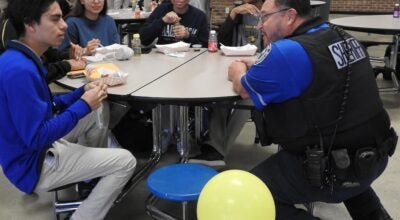Some fire safety tips while in the kitchen
Published 12:00 am Wednesday, October 12, 2011
Last week I wrote about protecting your family from fire. Lately the fire department has been on many fire-related calls due to cooking, so I have some tips.
Many families gather in the kitchen to spend time together, but it can be one of the most hazardous rooms in the house if you don’t practice safe cooking behaviors. Cooking equipment, most often a range or stovetop, is the leading cause of reported home fires and home fire injuries in the United States. Cooking equipment is also the leading cause of unreported fires and associated injuries.
Safe cooking behaviors
It’s a recipe for serious injury or even death to wear loose clothing (especially hanging sleeves), walk away from a cooking pot on the stove or leave flammable materials, such as potholders or paper towels, around the stove. Whether you are cooking the family holiday dinner or a snack for the children, practicing safe cooking behaviors will help keep you and your family safe.
Choose the right equipment and use it properly
• Always use cooking equipment tested and approved by a recognized testing facility.
• Follow manufacturers’ instructions and code requirements when installing and operating cooking equipment.
• Plug microwave ovens and other cooking appliances directly into an outlet. Never use an extension cord for a cooking appliance, as it can overload the circuit and cause a
fire.
Watch what you heat
• The leading cause of fires in the kitchen is unattended cooking.
• Stay in the kitchen when you are frying, grilling or broiling food. If you leave the kitchen for even a short period of time, turn off the stove.
• If you are simmering, baking, roasting or boiling food, check it regularly, remain in the home while food is cooking and use a timer to remind you that you’re cooking.
• Stay alert! To prevent cooking fires, you have to be alert. You won’t be if you are sleepy, have been drinking alcohol or have taken medicine that makes you drowsy.
If your clothes catch fire
If your clothes catch fire, stop, drop, and roll. Stop immediately, drop to the ground, and cover face with hands. Roll over and over or back and forth to put out the fire. Immediately cool the burn with cool water for 3 to 5 minutes and then seek emergency medical care.
Keep things that can catch fire and heat sources apart
• Keep anything that can catch fire – potholders, oven mitts, wooden utensils, paper or plastic bags, food packaging, towels or curtains – away from your stovetop.
• Keep the stovetop, burners and oven clean.
• Keep pets off cooking surfaces and nearby countertops to prevent them from knocking things onto the burner.
• Wear short, close-fitting or tightly rolled sleeves when cooking. Loose clothing can dangle onto stove burners and catch fire if it comes into contact with a gas flame or electric burner.
Use equipment for intended purposes only
Cook only with equipment designed and intended for cooking, and heat your home only with equipment designed and intended for heating. There is additional danger of fire, injury or death if equipment is used for a purpose for which it was not intended.
Protect children from scalds and burns
• Young children are at high risk of being burned by hot food and liquids. Keep children away from cooking areas by enforcing a “kid-free zone” of three feet around the stove.
• Keep young children at least 3 feet away from any place where hot food or drink is being prepared or carried. Keep hot foods and liquids away from table and counter edges.
• When young children are present, use the stove’s back burners whenever possible.
• Never hold a child while cooking, drinking or carrying hot foods or liquids.
• Teach children that hot things burn.
• When children are old enough, teach them to cook safely. Supervise them closely.
Prevent scalds and burns
• To prevent spills due to overturn of appliances containing hot food or liquids, use the back burner when possible and/or turn pot handles away from the stove’s edge. All appliance cords need to be kept coiled and away from counter edges.
• Use oven mitts or potholders when moving hot food from ovens, microwave ovens, or stovetops. Never use wet oven mitts or pot-holders as they can cause scald burns.
• Replace old or worn oven mitts.
• Treat a burn right away, putting it in cool water. Cool the burn for 3 to 5 minutes. If the burn is bigger than your fist or if you have any questions about how to treat it, seek medical attention right away.
Install and use microwave ovens safely
• Place or install the microwave oven at a safe height, within easy reach of all users. The face of the person using the microwave oven should always be higher than the front of the microwave oven door. This is to prevent hot food or liquid from spilling onto a user’s face or body from above and to prevent the microwave oven itself from falling onto a user.
• Never use aluminum foil or metal objects in a microwave oven. They can cause a fire and damage the oven.
• Heat food only in containers or dishes that are safe for microwave use.
• Open heated food containers slowly away from the face to avoid steam burns. Hot steam escaping from the container or food can cause burns.
• Foods heat unevenly in microwave ovens. Stir and test before eating.
How and when to fight cooking fires
• When in doubt, just get out. When you leave, close the door behind you to help contain the fire. Call 9-1-1 or the local emergency number after you leave.
• If you do try to fight the fire, be sure others are already getting out and you have a clear path to the exit.
• Always keep an oven mitt and a lid nearby when you are cooking. If a small grease fire starts in a pan, smother the flames by carefully sliding the lid over the pan (make sure you are wearing the oven mitt). Turn off the burner. Do not move the pan. To keep the fire from restarting, leave the lid on until the pan is completely cool.
• In case of an oven fire, turn off the heat and keep the door closed to prevent flames from burning you or your clothing.
• If you have a fire in your microwave oven, turn it off immediately and keep the door closed. Never open the door until the fire is completely out. Unplug the appliance if you can safely reach the outlet.
• After a fire, both ovens and microwaves should be checked and/or serviced before being used again.
On another note, the firefighters have a few events coming up in October. We are going to be at the Andouille Festival this weekend selling shirts, bracelets and pins to raise money for breast cancer. We also have scheduled the annual Guns & Hoses football game for Oct. 29 at Riverside for 9 a.m. We are collecting toys and canned goods to distribute throughout the parish, so come out and support your fire and police department.
Michael Heath is president of the St. John Professional Firefighters Association.





